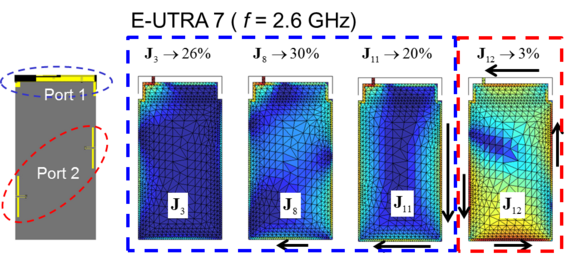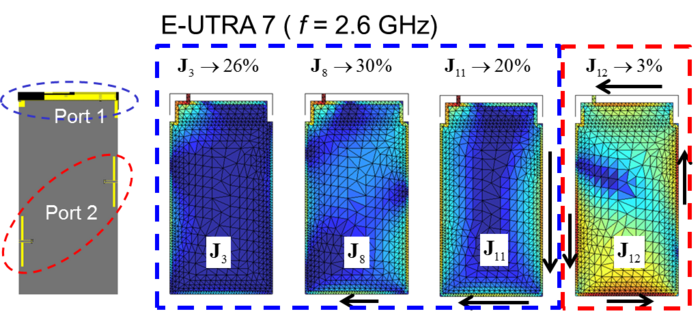When an initial antenna structure is given, for example a rectangular PEC plate representing a typical smart phone chassis, the first step is usually the modal analysis of the structure. This yields the eigenvalues and the characteristic currents. First, the eigenvalues are examined in order to find the significant modes and their resonant frequencies. If the significant modes do not fall into the desired frequency band, they may be manipulated, e.g. by altering the structure or introducing reactive loading. After that, the modal analysis is repeated and may be followed by a further redesign until the eigenvalues show a satisfying behavior.



In the next step, the corresponding characteristic currents are evaluated in order to decide how to excite the modes. Inductive or capacitive coupling elements are placed in current maxima or minima, respectively. Depending on the application, modes may be excited individually or simultaneously. After the port placement, the modal weighting coefficients are examined in order to assess how well the desired modes are excited. In general, different ports should excite different (sets of) modes. This may also be verified by evaluating the port correlation.
-
Tunable Antenna Systems for Handsets
Tunable Antenna Systems for Handsets
![]()
![]()
![]()
With the introduction of advanced wireless communication standards like UMTS and LTE(-Advanced) supporting high data rates and the introduction of multi-mode / multi-band capabilities of modern handsets, a significant increase of complexity in the phones RF section is observed. In this case, a miniaturization of the antenna size and the increase in bandwidth to be covered are required. To share the radio resources with respect to frequency and space efficiently, it is desired that the mobile devices have multiple closely-packed antenna elements for operation in so-called MIMO (Multiple Input Multiple Output) systems. Because of limited distance between the antenna elements, mutual coupling would typically lead to a degraded MIMO-performance. Moreover, the user interaction modifies the antenna impedance and mutual coupling and consequently degrades the power transfer unpredictably. Therefore, the design of small-sized multi-element broadband decoupled and matched antennas for providing a sufficient power transfer to the RF front-end on a compact mobile terminal is very challenging.
To mitigate these problems, besides optimizing the antenna structure itself, adaptive antenna tuning systems would be a promising approach. To provide some contributions, the Institute of Microwave and Wireless Systems (HFT) is developing efficient antenna system concepts, which includes state-of-the-art antenna elements as well as tunable decoupling and matching concepts for small-size single and multi-element antennas on compact mobile devices.
DESIGN CONCEPT FOR ANTENNA TUNABLE MATCHING SYSTEM
A design concept for a tunable antenna matching system containing tunable matching networks having a good tunability and small-sized single-element and weakly-coupled multi-element antennas for keeping the unpredictable antenna impedance mismatch of a reconfigurable operation band over the desired frequency range to be less than a predefined matching criterion has been developed. The evaluation of this concept has been realized in a practical phone mock-up system. This system is based on commercial RF-components for the frequency range of 0.69 ≤ f [GHz] ≤ 2.7, containing a low-band (0.69 ≤ f [GHz] ≤ 0.96) and a high-band (1.71 ≤ f [GHz] ≤ 2.7).
Firstly, tunable matching networks with a good tunability have been studied, which included to consider other (parasitic) components within the adaptive antenna system such as ESD protection circuits and a impedance detector.
References
[1] R. Martens and D. Manteuffel, "2-port antenna based on the selective excitation of Characteristic Modes," Proceedings of the 2012 IEEE International Symposium on Antennas and Propagation, Chicago, IL, 2012, pp. 1-2, doi: 10.1109/APS.2012.6349249.
[2] R. Martens, J. Holopainen, E. Safin, J. Ilvonen and D. Manteuffel, "Optimal Dual-Antenna Design in a Small Terminal Multiantenna System," in IEEE Antennas and Wireless Propagation Letters, vol. 12, pp. 1700-1703, 2013, doi: 10.1109/LAWP.2013.2296147.
[3] R. Martens and D. Manteuffel, "Systematic design method of a mobile multiple antenna system using the theory of characteristic modes," in IET Microwaves, Antennas & Propagation, vol. 8, no. 12, pp. 887-893, 16 Sept. 2014, doi: 10.1049/iet-map.2013.0534.





